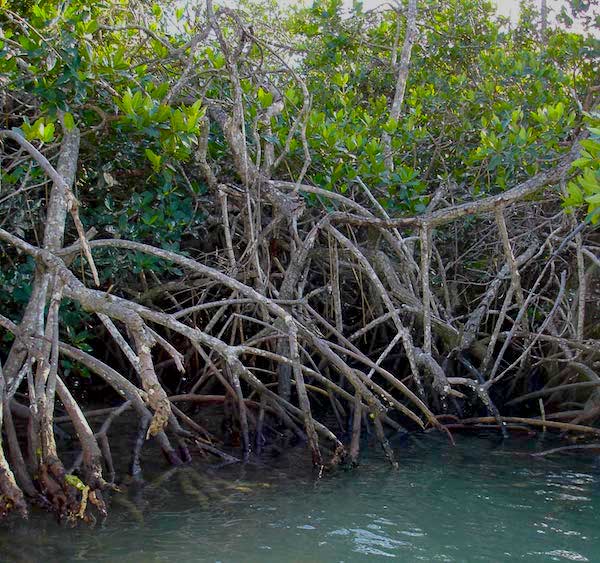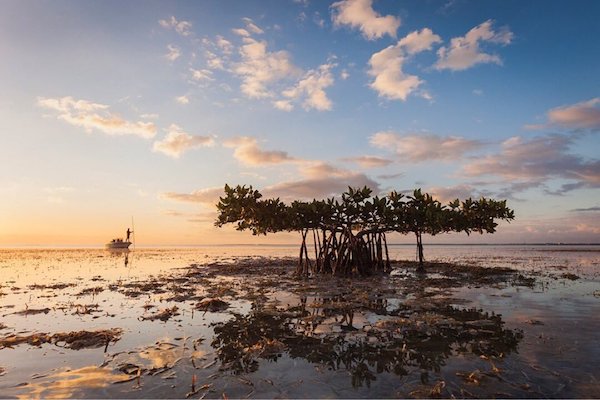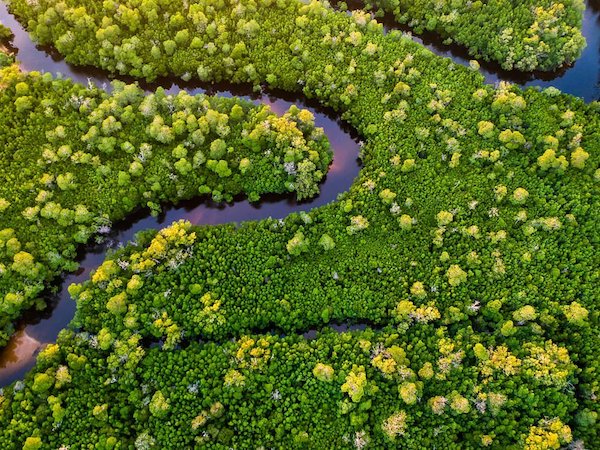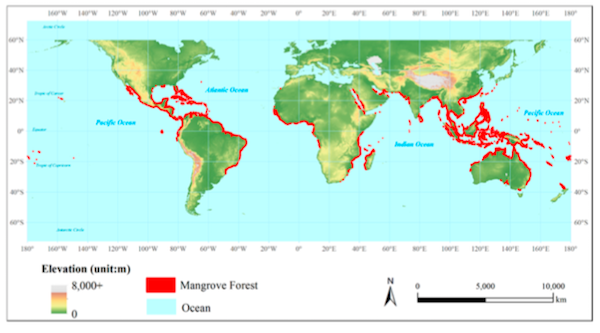By Lambert Strether of Corrente.
Readers will have noticed the headline is similar to this headline: “Coral Reefs, Climate Change, and Mobilization.” Same thing, different day, as I discovered after seeing a successful project on mangrove restoration go by on the Twitter, and then looking into mangroves. As before, I’m going to begin with the beauty of mangroves. A mangrove forest from close up[1], in Florida:

From farther away, also in Florida, a mangrove copse:

And an aerial view of an enormous forest, from Kenya:

(All these mangroves are smallish, but the mangroves of Gabon have attained heights of ~63m.)
So what are mangroves? From NOAA:
There are about 80 different species of mangrove trees. All of these trees grow in areas with low-oxygen soil, where slow-moving waters allow fine sediments to accumulate. Mangrove forests only grow at tropical and subtropical latitudes near the equator because they cannot withstand freezing temperatures.
Many mangrove forests can be recognized by their dense tangle of prop roots[2] that make the trees appear to be standing on stilts above the water. This tangle of roots allows the trees to handle the daily rise and fall of tides, which means that most mangroves get flooded at least twice per day. The roots also slow the movement of tidal waters, causing sediments to settle out of the water and build up the muddy bottom.
Mangrove forests stabilize the coastline, reducing erosion from storm surges, currents, waves, and tides. The intricate root system of mangroves also makes these forests attractive to fish and other organisms seeking food and shelter from predators.
From the Food and Agriculture Organization:
Mangroves are defined as assemblages of salt tolerant trees and shrubs that grow in the intertidal regions of the tropical and subtropical coastlines. They grow luxuriantly in the places where freshwater mixes with seawater and where sediment is composed of accumulated deposits of mud. Mangrove wetlands are normally classified into six types on the basis of the geophysical, geomorphological and biological factors. They are (a) river dominated, (b) tide dominated, (c) wave dominated, (d) composite river and wave dominated, (e) drowned bedrock valley mangroves and (f) mangroves in carbonate settings (Thom, 1984). The first five types of mangrove wetlands can be seen on coasts dominated by terrigenous sediments (shallow marine sediment consisting of material derived from the land surface) whereas the last one can be seen in oceanic islands, coral reefs and carbonate banks. Mangrove environment is highly dynamic and harsh and mangrove species are variously adapted to cope with these environmental conditions.
Mangrove wetland is a multiple use ecosystem. It is considered as a best form of coastal bioshield since it plays a critical role in reducing the impact of cyclonic storms, hurricanes and tsunami on human lives and properties (Danielsen et al., 2005; Selvam, 2005). It also avoids or reduces soil erosion. It enhances fishery productivity of the adjacent coastal waters by acting as a nursery ground for commercially important fish, prawn and crabs and supplying organic and inorganic nutrients. They are also rich in biodiversity and act as habitats for wildlife.
Obviously, such a beautifully adapted plant and its associated ecosystem will be under threat in the biosphere that the squillionaires are shaping for us; but this is the mangrove remediation story that got me thinking about writing this post. From Yale Environment 360, “On Java’s Coast, A Natural Approach to Holding Back the Waters” (forgive the long quote):
[Timbulsloko, is a village of 3,500 people on the north coast of the Indonesian island of Java. It] had been on a prosperous, rice-growing river delta, famous for its fertile soils and protected from the ocean by a wide belt of mangroves. … Like almost every other coastal community in the area, they had wanted to make money by raising prawns and milkfish. So they converted their rice fields into ponds and began cutting down the mangroves along the shore to make more[3].
“Before, we had a good life with rice and fish,” a villager says. “Now we only have a memory of agricultural land.” “Our parents warned us that we should protect the mangroves,” he remembered. “They said the mangroves provided many benefits, like the oysters, crabs, and fish among their roots, as well as protection of the coastline. But our people wanted to make money and feed their families.”
With the protective mangroves mostly gone, the sea began to wash away the dykes that surrounded the ponds. By 2013, it had penetrated inland for about a mile. The village has lost 25 rows of fish ponds, Sairi said. Now the waters lapped at their houses along the raised causeway. Other nearby villages had been entirely washed away.
We clambered aboard a boat from the end of the causeway to view a series of long permeable brushwood structures that they had erected in shallow waters that were once productive fields. The structures were rather like outsize nets on tennis courts, each more than 550 feet long and rising more than 3 feet above the waves. They were made up of two lines of vertical bamboo poles hammered 6 feet into the sea bed, with the gap between them filled by a mass of horizontal brushwood, held in place by netting.
The structures are not intended to keep out the water, which washes through. Instead, their purpose is to slow the waves coming off the Java Sea so that the tiny particles of sediment carried in the water will drop down and collect on the landward side of the structure, says Femke Tonneijck of the Netherlands-based NGO Wetlands International, which introduced the idea as part of a plan to revive mangroves in coastal regions around the world.
In essence, they are a tropical version of a traditional Dutch technique for catching sediment in salt marshes along the shores of the North Sea. The hope in Java is that the deposited sediment will provide a stable base where mangrove seeds floating in the water will germinate and grow, she says. The mangroves will collect yet more sediment, and slowly restore the coastline. After that, the brushwood structures will no longer be needed.
Timbulsloko was the first village to volunteer to erect these odd-looking structures, said Sairi, chair of the village group set up to build them. Construction had been hard work. Each required the labor of 25 people for four weeks. There had been teething problems. After clams began to eat the original vertical bamboo poles, they substituted PVC pipes filled with concrete. Others repairs were needed after storms.
But the structures were doing their job. When we reached the first, Sairi put a paddle into the water on either side of the barrier to check the depth. Eight months after its installation, the sea bed was already 6 inches higher on the landward side. In places, 2 feet had been added. The eroding shore was starting to rebuild.
By late 2018, nine villages in Demak had erected the brushwood barriers, which were catching sediment along almost 10 miles of coastline. If all goes to plan, they will eventually recreate a green belt of mangroves that will restore the entire coastline, protecting communities and creating new wetland habitat for water birds such as egrets, herons, and the endangered milky stork.
So, restoring mangroves is possible. Here is a scholarly paper from the Netherlands on the same topic: “A sustainable solution for massive coastal erosion in Central Java” (PDF). The problem statement:
Since the 1980s, establishment of aquaculture ponds along low-lying sedimentary reaches resulted in the near total destruction of mangrove forests. No less than 750,000 ha of forest were converted, mostly in western Indonesia. The aquaculture systems offered windfall profits initially, often to rich „patrons‟ from major cities. Following outbreak of diseases and accumulation of pesticide residues however, most systems collapsed leaving unproductive wastelands to the local population. The removal of the mangroves and confinement of the intertidal range due to construction of earth bunds around the shrimp ponds caused changes in sediment dynamics. This triggered massive erosion and the related land loss, inundation and salt water intrusion problems.
(Oddly, or not, Yale leaves out the “windfall profits” part.) And the solution turns out not to be the traditional approach:
Major investments have been made in traditional infrastructural responses – dams, sea-dykes and groins – in an attempt to resolve these problems. In most cases these failed to provide the desired protection and did not result in sufficient improvements in human welfare and economy. .. [M]angroves can only be successfully restored if the regional shoreline morphology (sediment flows, bathymetry etc.) and connection of the system to the river is to some degree rehabilitated as well. Most rehabilitation pilots do not reinstate these abiotic conditions. As a consequence they fail to stabilise eroding coastlines. Along many stretches of coast there is no response at all: they continue to degrade at an alarming rate.
We developed a new approach called ‘Hybrid Engineering’, which addresses delta and coastal vulnerability in an integrated manner. This approach accommodates economic and livelihood development needs, and combines technical and ecosystem-based solutions. The Hybrid Engineering approach is aimed to work with nature rather than against it. It combines engineering knowledge and techniques with natural processes and resources, resulting in dynamic solutions that are better able to adapt to changing circumstances. The focus of this report is on the technical solution at regional scale, i.e. a coastal stretch of 10 – 20 km long, building on experience gained with small scale pilots. The ultimate objective of this regional-scale Hybrid Engineering application is to regain coastal protection against erosion and other ecosystem services[4] by re-establishing a mangrove green-belt.
(Reminds me of permaculture, at least attitudinally.) So, you restore the mangroves as they were destroyed: 10 to 20 kilometers at a time, village by village (or in Florida, I suppose, county by county).
And there are a lot of mangrove forests to preserve or restore. From “Big Geospatial Data Analytics for Global Mangrove Biomass and Carbon Estimation” (PDF):

(Here is an interactive map from Global Mangrove Watch, and a second map, this one showing mangroves at risk, from Global Forest Watch. Sadly, neither are suitable for screen shots.)
And so we come to carbon. Mangrove forests are important carbon sinks, although apparently the only quantitative data we have comes from Australia. From the Guardian[5]:
Australia’s mangroves, tidal marshes and seagrass meadows are absorbing about 20m tonnes of carbon dioxide every year, according to a major new study that is the first to measure in detail the climate benefits of the coastal ecosystems. Dr Oscar Serrano, at Edith Cowan University’s Centre for Marine Ecosystems Research, said it found the coastal ecosystems stored between 4,000m tonnes and 6,300m tonnes of CO2. Australia’s annual emissions hit a record high in 2018 of 558.4m tonnes of carbon dioxide equivalent.
Serrano said: “When these ecosystems are damaged by storms, heatwaves, dredging or other human development, the carbon dioxide stored in their biomass and soils beneath them can make its way back into the environment, contributing to climate change.
“Globally, vegetated coastal ecosystems are being lost twice as fast as tropical rainforests despite covering a fraction of the area.”
Coastal ecosystems store carbon in their soils as well as in the plants themselves and, once absorbed, the carbon can be locked away for thousands of years if undisturbed. They are able to absorb at up to 40 times faster than forests.
“They also protect the coasts from erosion, are important nurseries for fisheries and they clear up the water so it’s very important for several reasons that we preserve these ecosystems,” Serrano said.
He said the ecosystems were being impacted by coastal developments, dredging and by climate change.
The annual losses of carbon from the coastal ecosystems was the equivalent of a 12% to 21% increase in Australia’s land-use emissions from activities such as land-clearing.
As with coral, we have a capital allocation problem. From Nature, “Where climate cash is flowing and why it’s not enough“:
Many people involved in climate finance say that a massive transformation is needed to unlock the trillions required to help the world shift to a low-carbon future and build resilience to climate change. Financiers will have to step away from approaching climate change on a project-by-project basis — a wind farm here, a solar plant there — and start thinking about the carbon impact of every dollar spent. That means an end to projects that lock in unsustainable futures, such as ill-designed buildings, agricultural practices that degrade land and destroy forests, or polluting transport systems. And since investors generally calculate in terms of profitable returns, it’s really up to policymakers to incentivize this shift by financially discouraging the wrong kinds of projects, says [Ottmar Edenhofer, director of the Potsdam Institute for Climate Impact Research in Germany, and a former co-chair of the IPCC’s working group on mitigation of climate change.]. He and many economists argue that putting a tax on carbon, or finding some other way to charge for emissions, could help create this shift. “If carbon prices increase, that would change the profitability of all investments,” he says.
But even though policymakers across the world are announcing plans to pursue carbon-neutral economies by 2050 or earlier, Edenhofer says, financial markets aren’t expecting significant risks from fossil-fuel-heavy investments. “It’s a very strange situation,” he says. “In the end, this is a message to policymakers that the markets do not really trust their announcements.”
Or a message from policy makers that financiers have successfully exercised their class power. Hard to tell from the outside. Can we just use a Jobs Guarantee to pay the farmers to use Hybrid Engineering and build the brushwood barriers? If we are to truly “listen to the science,” why does finance need to enter in at all? A topic for a another post…
NOTES
[1] When I wanted to attract birds to my garden, a reader told me that “birds love a mess.” They need twigs for their nests, they like branches to perch on, places to hide from predators like the cat, etc. But the mess turns out to create ecological niches for other creatures as well, like stick insects. Mangroves do the same thing. With camels, for example, in Gujarat, India:
The Kharai is a unique breed of camel found only in Kutch, which feeds on mangroves. These camels are unique Because they have the special ability to survive on both, dry land and in the sea. They swim in seawater and feed on saline plants and mangroves. pic.twitter.com/lH9jQt4Zu7
— Gujarat Information (@InfoGujarat) October 3, 2019
Camels love a mess!
[2] Root terminology seems a bit contested and not adequate to the complexity of its object of study. From The Dictionary of Botany, prop root: “Any of the adventitious roots that arise from the lower nodes of the stem in certain plants and serve to provide additional support…. The woody prop roots formed by certain trees are sometimes termed stilt roots. See also buttress root.” OK, buttress root: “A form of *prop root that is asymmetrically thickened to give a planklike outgrowth on the upper side, providing extra support for the tree. Buttress roots are common in many tropical trees, e.g. certain figs (Ficus)” — familar to Buddhists as the bodhi tree. The key fact is that the prop root is an aerial “breathing” root; in the mangrove, such roots exists at the interface of air and water: “An aerial root may be defined as a root which, for part of the day at least, is exposed to the air. The mangrove mud is rather anaerobic (oxygen poor) and unstable and different plants have root adaptations to cope with these conditions.” From the Food and Agriculture Organization: “These roots have numerous pores through which oxygen enters into the underground tissues.” Roots that breathe! I think that’s amazing.
[3] This story speaks to me because I know people in Thailand whose families did exactly the same thing, for the same reasons, with the same results.
[4] Watch out for that innocuous word, “services.” You can put a price on services. To me, this language has “code smell.”
[5] More “code smell”: “Prof Norman Duke, of James Cook University, who was not part of the study, said the advantage of quantifying the carbon stored in mangroves was that it created a ‘marketable commodity’ that could be used as part of carbon trading schemes.” What could go wrong?


This is a fascinating article this. The irony in it is that that Javanese village which destroyed their protective belt of mangroves to make some more money would have met with the full approval of a Milton Friedman – after his lectures in Iceland that is.
Thanks for posting this! Last year right around this time we were in Mexico visiting the Tortugaria – about an hour from Manzanillo. We took a boat ride around the most beautiful mangroves. We’re losing so much goodness.
Bookmarked for later.
Mangroves are one of the most wonderful habitats. Last time we walked through one, on a raised path, there was a continual “snap, crackle, pop” sound, which is a feature of mangroves.
“He said the ecosystems were being impacted by coastal developments, dredging and by climate change.”
Sadly, demographic growth is a huge threat.
> Sadly, demographic growth is a huge threat.
> The aquaculture systems offered windfall profits initially, often to rich „patrons‟ from major cities.
Demographic growth might seem a common-sense answer, but it’s a false frame. Coastal development along the Gulf Coast is a problem, but in this article, indigenous people in an environment which sustained them destroyed what they had for a short-term gain. “Our parents warned us that we should protect the mangroves” and were ignored. Not so much greed as ignorance, naivety being exploited with the dream of a better life. The Creation of Want.
I don’t have a great answer for this. Nature Conservancy had the best model I saw, preserving species by preserving habitat, but Hank Paulson gutted it. Turned the preserves into subsidized backyards for his buddies, and subverted the membership in the way described by Morningstar. But there’s still possibility there.
The mangroves could be a much more resilient land protection project than the coral reefs. The reefs are sensitive to change in temperature, acidity, and water depth, and all those are uncontrolled variables in rapid climate change. My impression is that mangroves are tough, it takes humans or high winds to knock them down, and high winds still leave a mess which slows fluxes down enough to allow quick rebound.
World-wide, supposedly approximately 35% of mangrove forests have been destroyed. One culprit is aquaculture, especially shrimp farming.
UN population estimate are 8.5 billion in 2030, and to increase further to 9.7 billion in 2050.
Threats include over-harvesting, over-fishing, agriculture, etc.
https://wwf.panda.org/our_work/oceans/coasts/mangroves/mangrove_threats/
at some point projected population increases will slow down and very possibly even reverse, as climatic change and environmental degradation negatively impact food production – as a first wave baby boomer with perhaps a couple decades left (although no one is promised tomorrow) i wouldn’t be surprised to see that happening even within my lifetime
I noticed on your map that northern New Zealand is threatened. That is an extremely narrow strip of land between two oceans, with much historical importance for the country as the Treaty of Waitangi was signed in the north and Maori have many legends about it. Mangrove restoration would seem to be a win/win project, but indeed in oceanic regions the enormous surges of tide that are being experienced will call for drastic measures in order for the coastlines to be preserved.
I love that ‘birds love messes’ idea. It motivates me to do something along that line along the slope below my house. Values change – who knew well kept lawns might become less prestigious?
I like it.
Some readers might enjoy a travel piece I wrote about the Sundarbans, the world’s largest mangrove forest: India and Bangladesh’s mysterious mangroves: The Sundarbans.
Thanks Jerri-Lynn, that’s a lovely article.
Wonderful article, thanks.
This was a good article. I toured mangroves on Sanibel Island, FL a few years ago. They are an important habitat for manatees. Thinking about “ecosystem-based solutions”, “ecosystem services”, definitely a smell, hard to avoid. Starting to stink. Thanks for the Cory Morningstar link too.